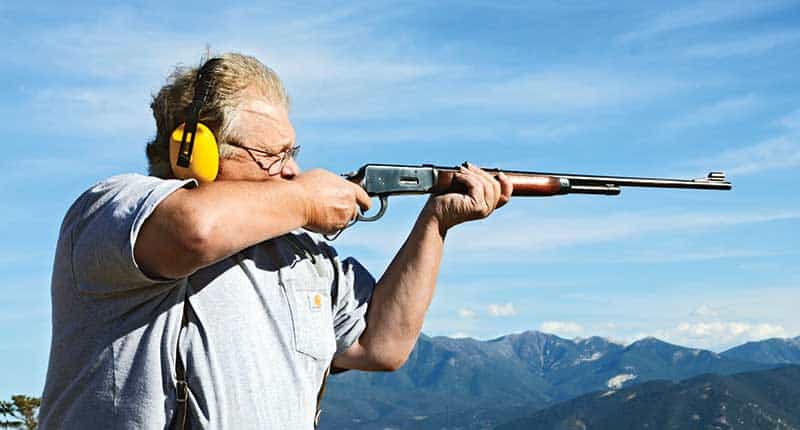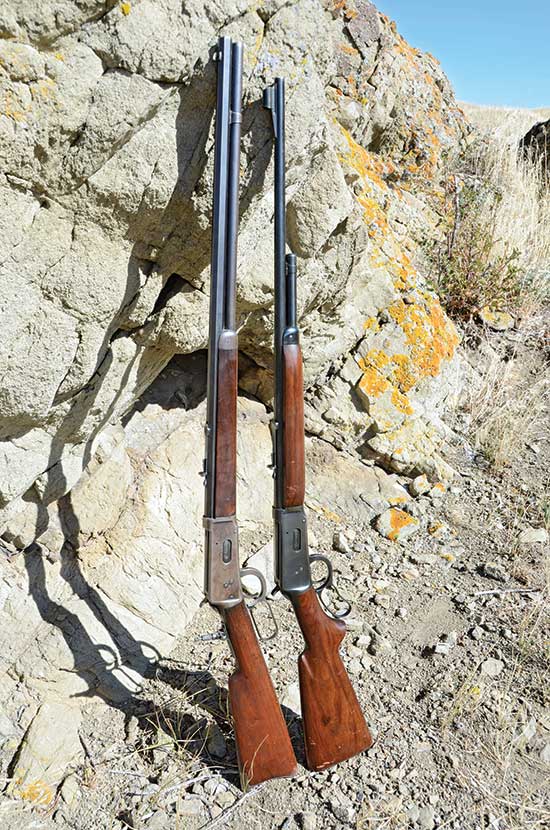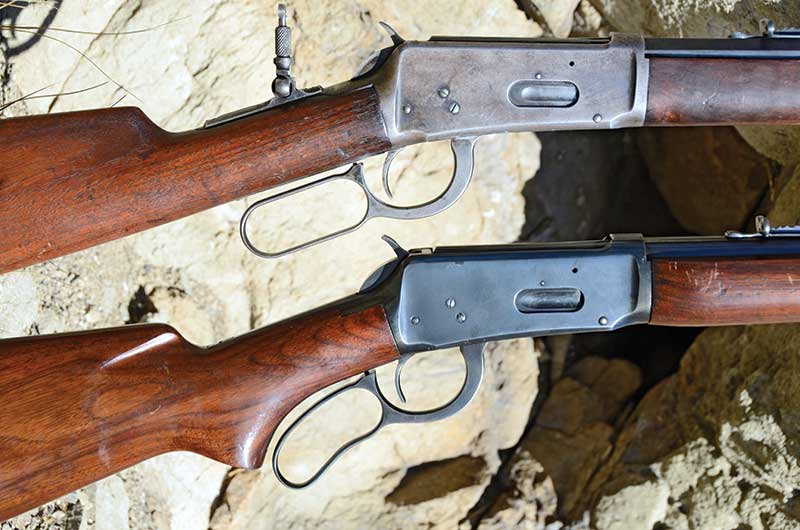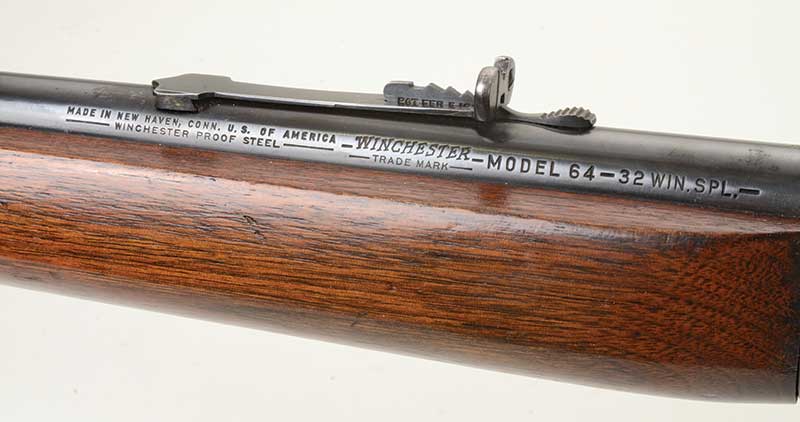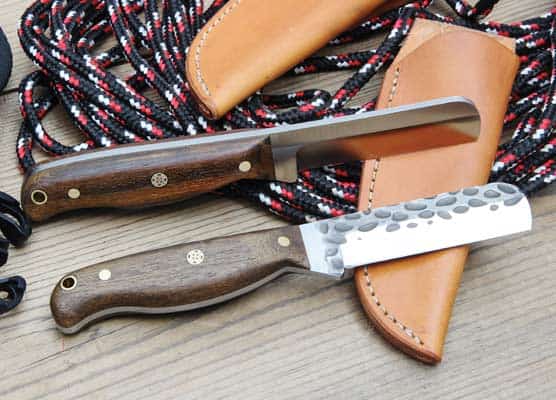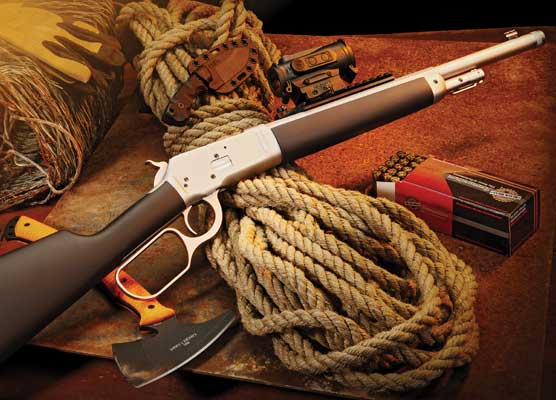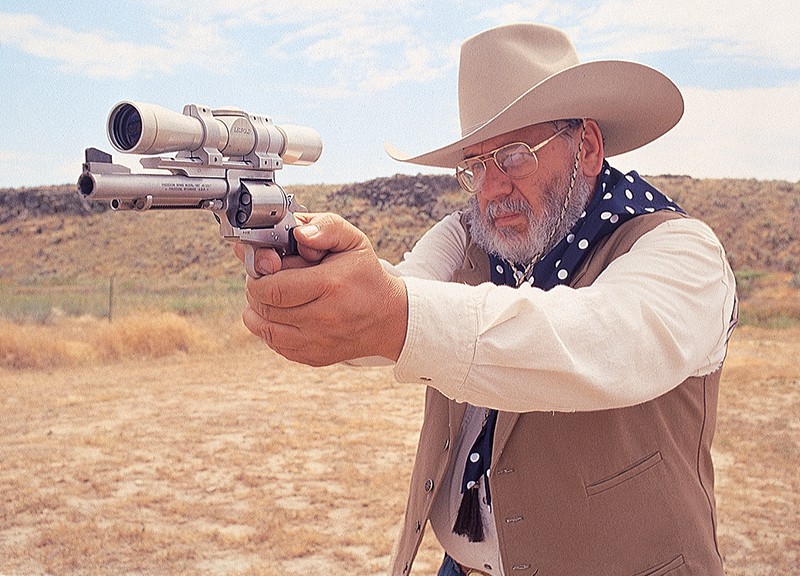Winchester's Model 64
Duke discovers a “Kissin’ Cousin”
to America’s Favorite Deer Rifle, a
graceful lever-action sporter
in .32 Winchester Special
Everybody who reads these pages knows what a Winchester Model 94 is. At least they should. But what about the Model 64?
I admit it took a few seconds for my brain to click in when a friend called to tell me about a “good deal” on one. Finally I said, “Oh yeah, the gussied up Model 94.” It happened to actually be a good deal, although it was in .32 Winchester Special. For some reason buyers seem to favor .30-30 or .25-35 when buying the Model 64. As with so much about gun buyers’ tastes, there’s no logic in that. So I bought it.
When Winchester introduced the Model 1894 it was their first rifle designed specifically for smokeless powder use. However, they didn’t get it on the market with smokeless calibers until 1895 because they were having trouble developing the nickel-steel needed for jacketed bullets. In 1894, the caliber options were .32-40 and .38-55, both featuring black powder and lead alloy bullets. Smokeless powder offerings in order of introduction were .25-35, .30-30 and .32 Winchester Special.
Model 94’s were sold in three basic configurations. There were rifles, carbines and military style muskets, the latter being extremely rare nowadays. A standard rifle had a 26-inch round barrel with a straight-grip stock, which featured a crescent-style steel buttplate. Octagon barrels were an-extra cost option but very popular. Off-the-shelf carbines had 20-inch round barrels.
From the 1870’s Winchester had been very accommodating about offering custom options. By the 1890’s they were selling fewer fancy rifles, especially Model 94’s. It was always considered more an “everyman’s deer rifle.”
Thirty years after their 1894 introduction Winchester ceased offering the Model 94 as a full-length rifle. Carbines, of course, stayed in production—making it especially confusing as to why they almost immediately began relying on Model 94 receivers to build up a new Model 55. The caliber offerings were all the same except the old black powder rounds were not included. Winchester offered Model 55’s— mostly as .30-30’s with 24-inch barrels and half magazines—for a dozen years. About 21,000 were made.
Then in 1933, during the worst of the Great Depression, Winchester decided to confuse everyone again. They introduced a Model 64. In standard dress the Model 64 had a 24-inch round barrel and was chambered for the same three smokeless calibers introduced in the Model 94. But instead of the straight-grip stock, the Model 64 had a pistol grip.
By 1937 Winchester decided to get into the varmint rifle market and so offered the Model 64 in .219 Zipper. That was the .30-30 case necked down to take .22 caliber bullets. The barrel length on the Zipper variant was 26 inches, although a few were also made with 22-inch barrels.
At the time, of course, optical sights were not so prevalent as today. As far back as the 1870’s Winchester had drilled and tapped the upper tangs of their rifle receivers so peep sights could be mounted. But by the advent of the Model 64 the practice was stopped. Instead, receiver-mounted peep sights were the rage and the company began drilling and tapping the left rear of their receivers to accommodate them.
As an experienced varmint shooter, I realize a .219 Zipper Model 64—even with peep sights—would have been a rather short-range varmint rifle, although it may have been effective to 100 yards or so on pests as large as rock chucks or groundhogs.
Anyway, it was probably a moot point as the Model 64 wasn’t offered in .219 Zipper (or .25-35 after 1941). In fact, no Model 64’s (or Model 94’s for that matter) were made between 1942 and 1948. When production resumed, they were offered on in .30-30 and .32 Winchester Special until 1956. Somewhere between 66,000 and 67,000 were manufactured. It is complicated to try pinning down an exact figure because Model 64 serial numbers were included among Model 94/1894 numbers.
This brings us back to the .32 Winchester Special Model 64 I bought recently. I had to do this research to help understand exactly what I’d acquired. Mine was made in 1953 and is a quintessential Model 64, with a 24-inch rapid-taper round barrel and half-magazine (it’ll hold five rounds). It features a pistol-grip stock and a shotgun-style steel buttplate. According to George Madis’ The Winchester Book, some had hard rubber buttplates. Interestingly, also according to Madis, buyers could special-order shorter barrels, but 24 inches was tops for length (except for those .219 Zippers).
The wood on this rifle is the plain, straight-grain American walnut with a sort of reddish/brown stain for which Winchester was famous. I’ve never seen a 20th Century Winchester rifle made prior to 1964 that didn’t have it. Besides the pistol-grip buttstock and shotgun-style buttplate, the forearm of a Model 64 is its most distinctive feature. It is of the beavertail or semi-beavertail style, meaning it thickens just ahead of the receiver, stays thick for most of its length, but then slims down again just before ending in its steel fore-end cap. Once more relying on Madis’ book, Winchester consulted with Col. Townsend Whelen—one of the most recognized riflemen of his era—on the basic Model 64 design.
My Model 64’s sights are the standard Winchester open type. The rear had a notched slider with six steps for elevation. It also has a small notched piece of steel inset into the rear assembly that can be loosened by means of a tiny screw and then moved for a perfect 100-yard zero. Of course, the rear sight can also be drifted in its dovetail for windage adjustment. The front sight is a hooded bead type set into a ramp machined integral to the barrel. Thus it has no provision for drifting as did most Model 94’s. As also was normal for Winchester back in the pre-’64 days, this Model 64 has a deep blue over a very smooth polish.
Let the Shooting Begin
In my 30-plus years of shooting Winchester leverguns, I’ve owned and fired extensively the Model 1894 in all of its five original calibers. The only one I’ve hung onto is the Model 1894 .38-55. However, I do remember the .32 Winchester Special rifle as being a particularly accurate specimen. After finishing my book Shooting Lever Guns of the Old West I assumed I’d no longer need a .32 Winchester Special and—rather stupidly—sold off all my brass and dies to fit.
Therefore, buying factory ammo was a must. To my surprise, Federal offers a factory load but none were available locally, so I settled for a box each of Remington and Winchester. All three firms rate their .32 Winchester Specials as having a 170-grain bullet at 2,250 fps. From my new rifle both brands were both faster than rated. Remington’s load hit 2,332 fps, Winchester’s was 2,335.
It would be nice to say that this Model 64 was a tackdriver. In truth it was… sorta, kinda. What I mean is, the first three shots at 100 yards printed into about 2 inches, but by the time five rounds were fired, things were closer to 4 inches.
And last I have to say this. It seems odd Winchester would drop Model 94 rifles in the 1920’s and then shortly thereafter reintroduce them as first a Model 55, then next a Model 64. In fact, perhaps except for the beavertail forearm, there isn’t a feature of the Model 64 that couldn’t have been an optional extra on Model 94 since its introduction.
Gun companies do strange things.
Factory Extras
Here are two more tidbits about the Model 64.
(1) Winchester offered a fancier “Model 64 Deer Rifle” with sling swivels, steel pistol-grip cap, checkered buttstock and fore-end and—if desired—double set triggers.
(2) In 1971/1972 Winchester tried reviving the Model 64. With the “blackened” sintered metal receiver—a change Winchester went to in 1964, it failed to grab the attention of rifle buyers and was dropped in 1973.
